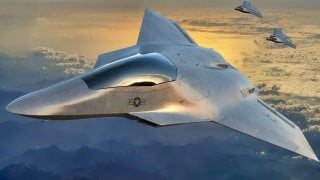China’s 6th Generation Fighter Is Trouble for the U.S. Military
China's efforts to conceptualize a sixth-generation fighter jet, as evidenced by social media teasers and concept art, demonstrate its commitment to closing the technological gap with Western military powers.
Summary: China's efforts to conceptualize a sixth-generation fighter jet, as evidenced by social media teasers and concept art, demonstrate its commitment to closing the technological gap with Western military powers. These preliminary glimpses suggest a tailless design, hinting at stealth and aerodynamic advancements inspired by, if not directly mirroring, American next-gen fighter concepts. However, the true status of China's sixth-generation fighter program remains shrouded in speculation, with conceptual designs serving more as indicators of intent rather than concrete progress.
China's Quest for Aerial Dominance: Decoding the Sixth-Generation Fighter Jet Race
China will certainly build a sixth-generation fighter jet – it is not a question of whether but of when.
Beijing wants to keep pace with American and European manufacturers already working to develop the next generation of fighters. But exactly how far along are the Chinese, who aim to achieve military parity with their Western counterparts?
What’s in a Picture?
The Chinese regularly release concept art for future stealth fighters. Of course, concept art, typically posted on social media, is not a blueprint. It isn’t even confirmation that any real work is happening at all.
However, one thing seems clear from the social media updates: The Chinese conceptualize their sixth-generation fighter as tailless. This happens to mirror the planned configuration of America’s Next Generation Air Dominance sixth-generation fighter. Coincidence? Probably not.
One 2023 post, from the Aviation Industry Corporation of China (AVIC), shared a CGI video portraying a sixth-generation fighter. The conceptual jet had two engines, diamond-shaped wings, a blended-wing body configuration, and no tail. In this configuration, it looked much like the Northrop Grumman YF-23, which lost the Advanced Tactical Fighter contract to the Lockheed YF-22.
“Such artwork and mockups should only be interpreted in the broadest of strokes at this stage,” Popular Mechanics reported. “Many conceptual designs don’t make it to production, and those that do inevitably undergo substantial revision.”
Rick Joe, who comments on social media about Chinese military technology, wrote that concept art of a “generic ‘tailless large future fighter’ … is ‘significant’ only in the sense that AVIC wouldn’t show a high-profile CGI if they weren’t working on a meaningful next-gen fighter. The details probably aren’t important so much as ‘stealthy tailless fighter’ is something they’re conformable signaling.”
What Is a Sixth-Generation Fighter?
Only three nations—the United States, Russia, and China—have built and fielded a fifth-generation fighter. The rest of the world relies predominantly on fourth-generation technology. Yet the race to develop sixth-generation technology is on—even though what exactly constitutes a sixth-generation fighter has never been clearly defined.
What we can say is that a sixth-generation fighter will be more advanced than a fifth-generation fighter. Improvements will include better stealth, internal weapons bays, advanced avionics, supercruise, thrust vectoring, data fusion, and interconnectivity. Sixth-generation platforms will likely include advanced digital capabilities, human-systems integration, variable cycle engines, and increased-range stand-off and beyond-visual-range weapons.
“Expected new capabilities include AI piloting assistance, drone-control capabilities, even more extensive networking of sensors with friendly forces than is found on the very networkable F-35, and flexible combined cycle engines capable of sustained supersonic cruising while generating enough electricity for powerful jammers or directed-energy weapons like lasers,” Popular Mechanics reported.
Can the Chinese beat America or the Europeans to sixth-generation technology? Probably not. The United States is peerless with respect to aerospace development. While China is rapidly expanding its military capabilities, it seems unlikely that Beijing could outpace the U.S. timeline to the sixth generation.
About the Author: Harrison Kass
Harrison Kass is a defense expert with over 1,000 published articles. An attorney, pilot, guitarist, and minor pro hockey player, Harrison joined the U.S. Air Force as a Pilot Trainee but was medically discharged. Harrison holds a BA from Lake Forest College, a JD from the University of Oregon, and an MA from New York University. Harrison listens to Dokken.
Image: Shutterstock.


